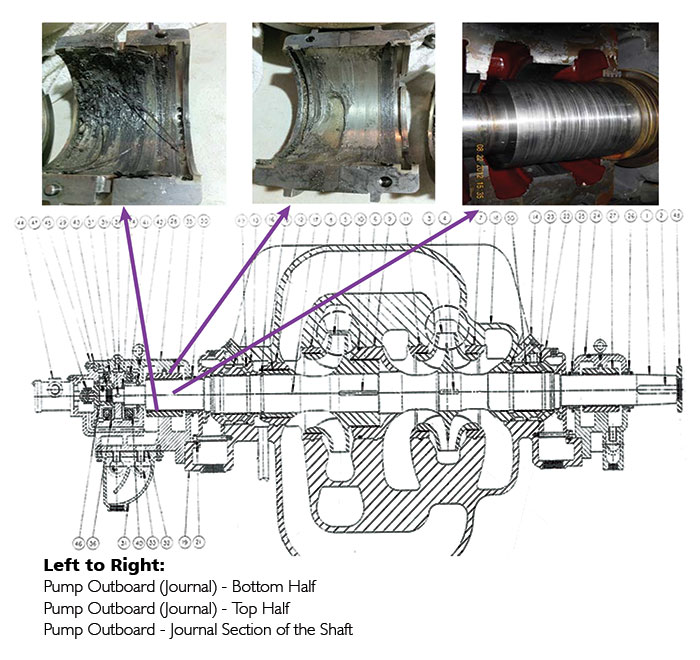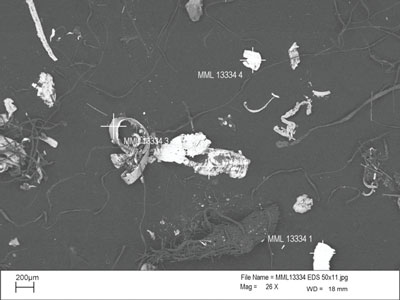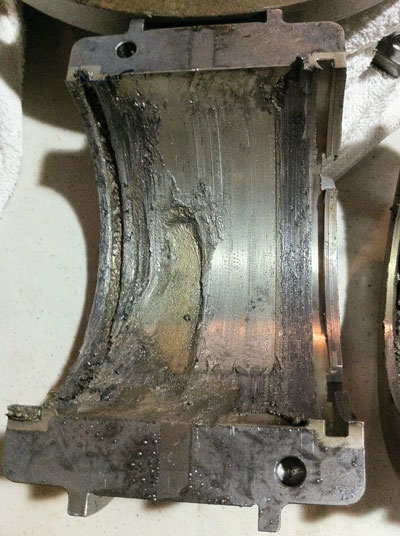Wire Wooling Bearing Failure: A Case Study
A nuclear plant recently experienced wire wooling on the journal bearings and shaft of one of its feed water pumps. This was detected by the color of the oil turning black during a post-maintenance acceptance run. The equipment did not have any form of filtration installed but just a rough strainer in the reservoir. The pump was turned off, and the strainer inspected.
The pump in question has a double volute design, which assures radial balance. It has specially constructed bearing housings that contain the thrust (outboard end) and radial (coupling end) bearings. The radial bearing is a split-sleeve journal bearing. The thrust bearing combines a split-sleeve journal bearing with a pivoted shoe bearing, thrust disc and locating ring.
Oil Lube System

The oil lubrication system furnishes lubricant under pressure to the pump and motor bearings. The lubricant for the motor is an ISO 32 grade turbine oil and is compatible with the lubricant required for the pump. For this design, the pump bearing housings are furnished with an oil deflector. The oil deflector has a nose ring that inserts between the labyrinth seal cast in the bearing housing and the pump shaft. There is also an outer ring that overlaps a lip, which is cast into the upper and lower bearing housings. The tight clearance between the oil deflector and pump shaft minimizes water intrusion as well as oil leakage.

During normal operation, all oil is supplied by the shaft-driven gear pump, while a motor-driven auxiliary oil pump is on standby. The pump’s lubrication system configuration is designed to start the motor-driven auxiliary oil pump when the main pump’s oil pressure falls below 7 pounds per square inch (psi). The intent in this configuration is to provide sufficient lubrication to the pump bearings in the event the shaft-driven gear pump fails while the pump is in normal operation. The motor is a 7,000-horsepower horizontal induction unit that is connected to the pump via a flexible coupling.
The pump’s rotating assembly (including impellers, shaft, wear rings, balance sleeve, journal bearings and balance stage pieces) was recently replaced to provide increased feed water flow to the boilers following the maintenance period. This change also modified the pump recirculation system and seal water injection system.
As noted previously, the pump requires a lube oil system. Its purpose is to provide lubrication and cooling to the pump thrust bearing, two radial journal bearings and the motor bearings. The lube oil system is self-contained and includes a shaft-driven oil pump, heat exchanger, strainer, pressure-relief valves, thermometers, pressure gauges, oil drain sight flow glasses for each bearing bracket, a reservoir, and an auxiliary motor-driven lube oil pump. The primary lube oil pump is mounted on the end of the main pump shaft. The auxiliary lube oil pump is mounted adjacent to the lube oil reservoir and is used as a backup to the main lube oil pump during startup. The lube oil cooler is utilized to cool the lube oil and receives cooling water from a separate cooling water system.
Signs of Bearing Problem
 In 2012, the modified feed pump was started to perform a pre-operational test. During the first portion of the run, vibrations (casing mounted) were noted as abnormal but acceptable. Audible noises resembling air expulsion and water spewing out from the pump seals were also noted. Following the test run, the pump oil sample showed an abnormal black color and particle content. An additional oil sample was obtained and sent for independent lab analysis.
In 2012, the modified feed pump was started to perform a pre-operational test. During the first portion of the run, vibrations (casing mounted) were noted as abnormal but acceptable. Audible noises resembling air expulsion and water spewing out from the pump seals were also noted. Following the test run, the pump oil sample showed an abnormal black color and particle content. An additional oil sample was obtained and sent for independent lab analysis.
The elemental spectroscopy showed abnormal levels of iron and tin. Because lead was not seen in the sample, it initially was reported that no bearing damage had occurred. Based on these results and in-depth discussions, a visual inspection of the main oil pump suction filter was performed. This showed visible debris/shavings consistent with shaft and bearing materials.
In order to determine where the debris was generated, the covers of the outboard and inboard bearing housings were opened. When the outboard bearing cover was lifted, maintenance personnel discovered strings of metal that appeared to be shavings of bearing metal (Babbitt). The outboard radial bearing was completely destroyed. The shaft also had radial grooves that were similar in appearance to those made by a cutting tool.
The inboard bearing showed signs of having the same outcome given enough time. The thrust bearing shoes appeared to be in as-new condition, but both the inboard and outboard thrust seal rings had linear indications and discoloration due to extreme heat.
 The rotor was removed from the casing and inspected. All close-clearance mating components (case rings, impeller hub, balance sleeve, balance bushing, throttle bushing and throttle sleeve) exhibited contact, with the most contact occurring at the second-stage case ring and impeller eye hub. Subsequently, a plan was developed and executed to inspect the bearings of the similar redundant pump, which had also been upgraded. The pump bearing housing caps were removed along with the upper radial bearing halves. Fine metal particles were found. This prompted the development of a more rigorous flushing plan for the pump’s lube oil system.
The rotor was removed from the casing and inspected. All close-clearance mating components (case rings, impeller hub, balance sleeve, balance bushing, throttle bushing and throttle sleeve) exhibited contact, with the most contact occurring at the second-stage case ring and impeller eye hub. Subsequently, a plan was developed and executed to inspect the bearings of the similar redundant pump, which had also been upgraded. The pump bearing housing caps were removed along with the upper radial bearing halves. Fine metal particles were found. This prompted the development of a more rigorous flushing plan for the pump’s lube oil system.
Based on a preliminary review of the vibration data and physical inspection of the pump’s bearing and rotor, it was concluded that the bearing damage was caused by foreign material introduced into the journal regions. This foreign material could be emanating from the closed-loop oil lubricating system, as supported by the metallic grit found in the other pump’s bearings. The shaft journals are not chrome-plated, which makes these areas susceptible to wire wooling.
The bearing damage was initiated on the outboard end of the feed pump. This was evident by the greater damage on the outboard journal bearing as well as by the greater wear on the most outboard case ring, which acts as the water-lubricated outboard bearing once the journal bearing fails.

Wire Wooling Failure
The failure mode supported is a condition known as “wire wooling.” Wire wooling requires shaft material chromium content between 3 to 20 percent and foreign particulate (hard or soft). The failure sequence entails the following:
- Introduction of foreign particulate into a tight clearance (in this case, the bearing-to-journal annulus) and filtered to less than 15 microns.
- Generation of frictional heat due to particle rub at high speeds (greater than 3,700 feet per minute).
- Conversion of chromium to hard chromium carbide in the steel shaft and in the presence of hydrocarbon oil.
- Embedding of chromium carbide particles in the stationary component (bearing) acting as a cutting tool.
Air ingestion had no factor in the bearing failure. This condition would have been seen first as a hydraulic imbalance in the first-stage impeller. If air ingestion had been the failure mechanism or contributed to the failure mechanism, then the inboard bearing would have been more distressed and would have initiated the event. Air ingestion also would have caused extreme transient axial loads that would have exercised the thrust bearings and left indications or damage on the inboard and/or outboard thrust shoes.
 If air ingestion produced high radial loads, then air would have resided in the wear ring annulus locations, significantly reducing the stiffness and damping of these water-lubricated bearings (Lomakin effect). This would have resulted in more contact between the impeller hub and wear rings than was found during the rotating element inspection.
If air ingestion produced high radial loads, then air would have resided in the wear ring annulus locations, significantly reducing the stiffness and damping of these water-lubricated bearings (Lomakin effect). This would have resulted in more contact between the impeller hub and wear rings than was found during the rotating element inspection.
The loss of wear ring stiffness would have led to increased rotor motion with a resulting increase in vibration amplitude. The only increase in vibration during the event was at vane pass frequency, which was caused by the exiting air impacting the volute cutwater.
Air ingestion was addressed by revising the procedure for venting the pump casing prior to startup.
The Root Cause
The pump experienced a significant equipment failure due to the introduction of foreign material into the lube oil system.
Debris Size and Type
Predictive maintenance (PdM) analysis revealed debris that was consistent with machine (metal) cuttings. The foreign material was possibly introduced into the pump bearing through the lube oil supply/return lines, bearing housings and oil reservoir.
 The piece was analyzed with a scanning electron microscope using energy dispersive X-ray spectroscopy semi-quantitative analysis. The composition of the debris was consistent with stainless steel. Furthermore, the morphology resembled a piece of cold drawn wire.
The piece was analyzed with a scanning electron microscope using energy dispersive X-ray spectroscopy semi-quantitative analysis. The composition of the debris was consistent with stainless steel. Furthermore, the morphology resembled a piece of cold drawn wire.
Prior to this event, the primary PdM technologies in use consisted of surface-mounted accelerometers, thermography and oil analysis. Vibration data was somewhat useful during the event. However, oil analysis was the main technology utilized to identify the problem. This led to further investigation. Subsequent to this event, proximity probes and bearing resistance temperature detectors (RTDs) were installed on this and three other similar pumps.
In reviewing the damaged components, it was discovered that the motor bearings and pump radial/thrust bearings were all affected by the foreign material.
Conclusion
The nuclear plant relied upon existing maintenance activities for lube oil system cleanliness control. These cleanliness controls were insufficient for ensuring the health of the feed water pump when the lube oil system was completely disassembled and its components reused.
